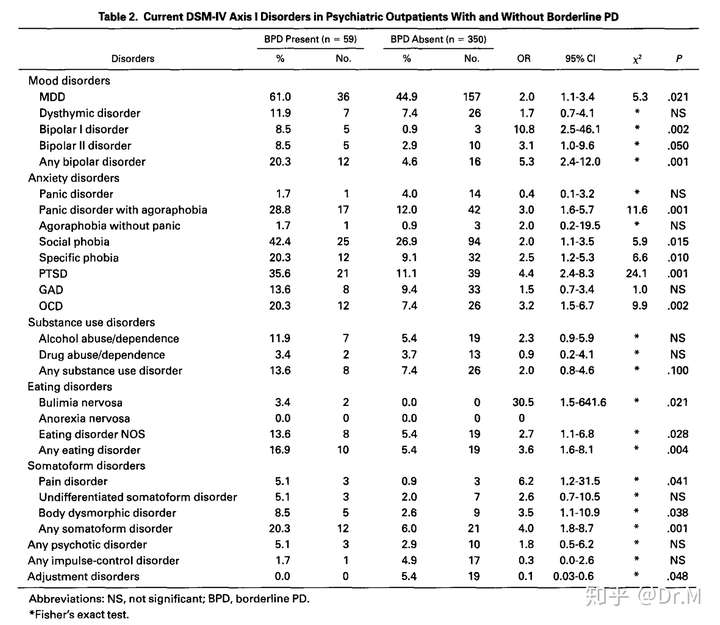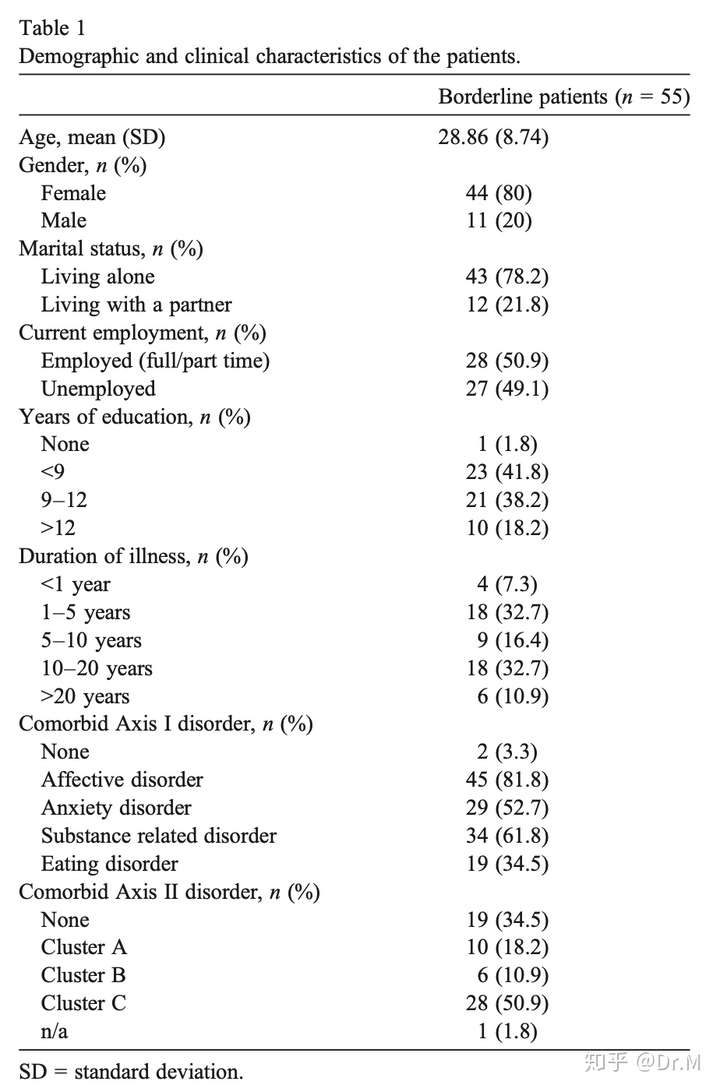请登录
注册
 丁香医生审稿专业委员会同行评议通过
丁香医生审稿专业委员会同行评议通过边缘型人格障碍可以跟抑郁症共存吗?
简短地来回答这个问题(每次都这么说,最后都不简短),我的临床专攻是边缘性人格障碍症:
- 抑郁症和边缘性人格障碍症,两者之间没有排他性,也就是说某人是可以同时满足抑郁症和边缘性人格障碍症的诊断标准,同时被诊断为抑郁症和边缘性人格障碍症的。
- 抑郁症和边缘性人格障碍症的共病率是很高的,更准确地来说,如果某人患有边缘性人格障碍症,那么 TA 同时患上抑郁症、焦虑症等情绪障碍的概率是显著提高的。在临床上来说,有相当一部分边缘性人格障碍症的患者同时也满足抑郁症的诊断标准,这是临床上很常见的现象。
- 除了抑郁症、焦虑症外,和边缘型人格障碍症最常见的共病还有创伤后应激障碍症 PTSD、饮食障碍、毒品成瘾。比如我以前是做饮食障碍症的,但很多病患同时有边缘,然后做了边缘以后,发现绝大多数病患有过显著的创伤经历,所以又开始做 PTSD。边缘型人格障碍症是一个相对比较复杂的精神疾病,和其他精神疾病共病的现象很普遍,这也是边缘的一个特点。
不如我们来看一下临床数据:
这篇文章对 409 位患有精神疾病的病人进行了系统的诊断,把患有边缘性人格障碍症的病人(59 名)和不患有边缘性人格障碍症的病人(350 名)进行了对比,结果如下:
Borderline PD patients were twice as likely to receive a diagnosis of three or more current axis I disorders (69.5% v 31.1%) and nearly four times as likely to have a diagnosis of four or more disorders (47.5% v 13.7%).
也就是说:边缘性人格障碍症患者,与没有边缘性人格障碍症的病人相比,同时患有三种或以上的临床障碍(包括常见的情绪障碍)的概率是比较组的两倍,同时患有四种或以上的临床障碍(包括常见的情绪障碍)的概率是比较组的四倍。
In comparison to nonborderline PD patients, borderline PD patients more frequently received a diagnosis of current major depressive disorder (MDD), bipolar I and II disorder, panic disorder with agoraphobia, social and specific phobia, posttraumatic stress disorder (PTSD), obsessive~compulsive disorder (OCD), eating disorder NOS, and any somatoform disorder.
这里说的是:和没有边缘性人格障碍症的病人相比,边缘性人格障碍症患者更容易被诊断为抑郁症、双相情感障碍、惊恐发作、社交恐惧症、创伤后应激障碍症、强迫症、饮食障碍症、以及身体化障碍。
具体数据见下表:

可以看到抑郁症(MDD)的发病率,在边缘性人格障碍症患者中,是显著提高的(p = .021)。
作者对 60 位患有边缘性人格障碍症的患者进行了系统的诊断,结果如下:
Forty~five BPD patients (81.8%) had a comorbid affective disorder of which 15 (27.3%) were diagnosed with an atypical depression.
也就是说:81.8% 的边缘性人格障碍症患者同时被诊断为情感障碍(包括抑郁症和双相情感障碍等),而其中 27.3% 的病人被诊断为非典型的抑郁症,其他常见的共病包括焦虑症、毒品成瘾、饮食障碍症。
具体数据见下表:

重点看 「affective disorder」。
关于治疗,有这样一些想法:
- 准确的诊断是治疗成功最重要的基础,接受全面的诊断,确诊是否同时患有边缘性人格障碍症和抑郁症,排除有没有其他病症,比如焦虑症、PTSD、毒品成瘾、饮食障碍症等。边缘性人格障碍症最好找有这方面专攻的精神科医生或临床心理学家来做。
- 如果抑郁症对人身安全带来显著的影响(比如自杀意念显著、频繁),或者抑郁症对治疗带来显著干扰(比如卧床不起、完全没有动力精力接受治疗、认知能力不足),那么先要接受抑郁症的治疗,然后再接受边缘性人格障碍症的治疗。我们曾经有病人严重到需要住院接受抑郁症治疗和观察(抗抑郁药物没有效,最后采取电击),然后才可以展开边缘性人格障碍症的治疗。
- 在大多数情况下,只要抑郁症的干扰不是太显著,那么应该首先接受边缘性人格障碍症的治疗(比如采取」 金标准 「辩证行为疗法 DBT)。一般来说,当边缘性人格障碍得到改善后,当情绪管理能力得到提升时,抑郁症的病症就会显著的减弱,因为辩证行为疗法本身对情绪障碍比如抑郁症也可以起到治疗效果,可能不再需要专门针对抑郁症进行干预。在接受边缘性人格障碍症治疗时,也可以同时接受抗抑郁药。或者完成边缘性人格障碍症治疗后,再接受抑郁症的心理治疗。
相关文章

边缘性人格障碍患者害怕被抛弃到底是怎样的?
「害怕被抛弃」是边缘性人格障碍的诊断标准之一,也是边缘性人格障碍的特征之一。不夸张的说,「害怕被抛弃」可以说是边缘性人格障碍和其他精神疾病最不同的地方之一。关于边缘性人格障碍的诊断标准[1]:第一条叫做:「疯狂地努力避免被别人抛弃」。其实讲到这里,这个问题就算回答完成了:当边缘性人格障碍患者遇到被抛弃的情况时,会采取「疯狂的行为」去避免自己被抛弃,重点在于「疯狂」和「避免」。边缘性人格障碍患者害怕

你是边缘型人格吗?快来免费测一测
情绪波动大,极度不稳定边缘性人格障碍,是一种介于神经症和精神病之间的心理障碍它不仅影响本人的生活,也会给身边的人带来困扰你是否有边缘型人格的特质?来测一测吧 ?*如果此处显示空白,请将丁香医生 App 更新至最新版本「这是什么测试」1. 这是一个用来评估边缘型人格障碍特质的自测工具,通过这个测试,你可以了解自己是否具有边缘型人格障碍的特质2. 这套自测共有 10 个题目,预计 3 分钟内可以完成

容易被小事激怒、自我价值感低,小心这种人格障碍悄悄找上门
容易被激怒、自我价值感低,可能是边缘型人格障碍的表现。边缘型人格障碍是人格障碍的一种,它最明显的特点在于患者的自我认识、人际关系和情绪状态都是不稳定的,行为往往很冲动。边缘型人格障碍有什么表现?1. 容易被小事激怒,往往只能感到短暂的快乐,经常感觉空虚、厌倦;2. 会在一些方面无节制地放纵,例如挥霍金钱、赌博、暴食等;3. 对待人际关系时,往往在过分理想化和过分贬低之间来回变化,比较极端;4. 对

边缘性人格障碍患者如果遇到了他所认为的被抛弃,会有怎样的反应?
一般来说,边缘性人格障碍患者会采取以下三种行为模式(主要来自我的临床经验):1. 在被别人抛弃之前,主动终止关系,断绝一切联系,从而保护自己。这个模式还可以细分为两种:第一种是单方面地、突然性地终止和对方的关系,删除一切联系方式,抹去生活中这个人曾经存在过的种种迹象,好像这个人就从来没有出现过一样,然后与这个人从此不再有任何交集,英文里称为 ghosting,大家可以自己去搜索一下。第二种是突然性